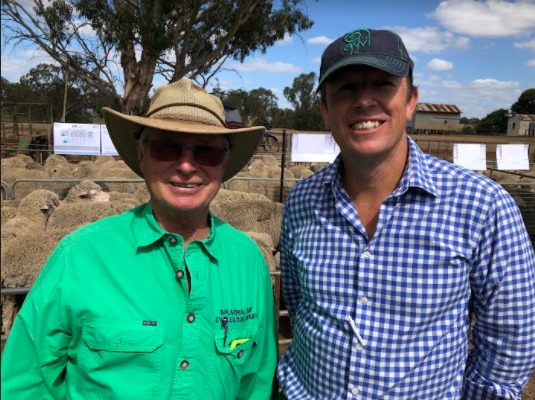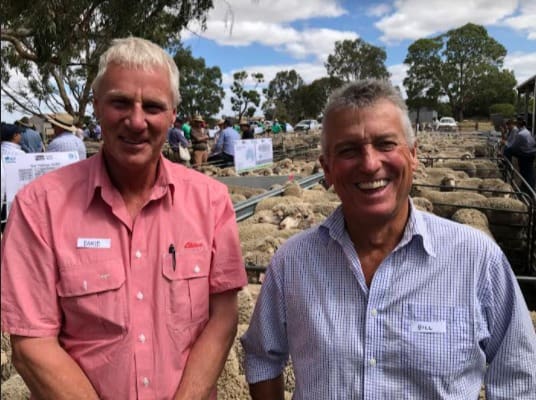
Tom Silcock and AMSEA executive officer Ben Swain at the Tuloona field day.
AUSTRALIA’S biggest Merino research project in the world is helping to dispel sheep breeding myths about breeding for wool and meat, according to organisers and classers involved.
The project is also seen as alerting growers of the existence of sheep that can increase non-mulesed wool production.
The Merino Lifetime Productivity Project trial held its final field day at its ‘Tuloona” site near Harrow in western Victoria last week.
One of the founders of the project, stud breeder and classer Tom Silcock said he was rapt that the trial had highlighted the “different deviations in genetics” over the lifetime of sheep.
“So some get better and some get worse – some hold their micron better and some hold their wool quality better.”
He said the relationship between the deviation in trait expression and breeding values is still being “unwrapped”.
“But 20 years ago some of us were saying there was a big difference in the longevity of some genetics then in wool quality and fleece weight, but we weren’t successful in proving that then.”
He said the trial had proved this point. On the issue of fleece weight repeatability, Australian Merino Sire Evaluation Association executive officer Ben Swain Ben Swain said a preliminary Harrow data analysis showed that post-weaning measurement of clean fleece weight provided a “reasonably good” prediction of lifetime productivity, but the correlation weakened with age.
“Whereas if we do one adult one (measurement), our correlation to the end is much better.
“What I would say is if you are interested in adult fleece weight as a production driver, you should measure adult fleece weight.”
Mr Silcock hoped the project would give a better understanding of the correlation of fertility with other traits and would help the industry use genomics for hard to measure traits.
He believed the MLP project would show that Merino producers could have it all in their sheep – fertility, fleece, weight, micron, early growth, fat and muscle. He said some Merino and Dohne genetics “had it all” and it was not true that producers had to make a choice between fleece or carcase.
“You can have it all, alright there are not the numbers and everything, but they’re coming, it’s a very exciting spot to be in.
“I believe the future Merino will be a prime lamb sheep that is growing super quality fine wool.”
Mr Silcock said there had been a perception that to maintain fleece weight required “a bit of wrinkle,” whereas some of the top-performing ewes in the trial did not necessarily need mulesing.
He said that within the MLP Project there had been sheep with low breech wrinkle and “reasonable” body wrinkle and were good wool cutters.
“If nothing else it has given us the opportunity to see and identify these sheep,” he said.
“I’m aware that a lot of people in the industry say that there is a high correlation between body wrinkle and breech wrinkle – I don’t agree with that.
“I think there are curve benders there that I have seen, that are very good for breech wrinkle, but with a good wool cut and just a nice amount of skin on them.”
Mr Swain said the project would help answer the questions about the trade-off between plain bodied low wrinkle sheep and fleece weight, for producers aiming at a non-mulesed flock.
“And I think some of the results from Tuloona show that there are rams out there that are plain, and below industry average for breech wrinkle, but above industry average for fleece weight.”
The numbers of rams of that type in the industry had increased since the MLP project started, he said.
“In the current sire evaluation trials, we are seeing sheep that are certainly below average breech wrinkle and above average for fleece weight – they are the ones we’ve got to use.
“People are wanting them and they are finding them now.”
In a summary of the correlations seen from preliminary MLP results at Harrow, Mr Swain said the Harrow data showed there was no correlation between ewe size – big or small ewes — and how many kilograms of lambs they reared. He said there was a low negative correlation between highly fertile ewes and wool production, but there were plenty of ewes “that cut heaps of wool and reared heaps of lambs.”
“Those ewes that rear lots of lambs, tend to cut less wool, on average but there are plenty of ewes that do both.”
He said it was also not necessarily true that ewes that did not rear a lamb would cut a lot of wool.
The perfect sheep are out there….

Sheep classers for the Tuloona MLP site, David Whyte, left, and Bill Walker.
Elders Hamilton manager and sheep classer David Whyte said his role was to score the sheep for 10 traits without knowing anything about their fertility.
“There has been some sheep come through that are exceptionally top ewes – not many of them – and they have had 10 lambs (in five years) and they are still performing as top sheep after that period, which is quite incredible.
“There some exceptional sheep out there that do provide everything we are looking for,” he said.
“I was always told that there are no perfect sheep, no perfect Merino sheep, but with all the testing and measurement, and scoring, we can certainly identify all those perfect sheep.”
Murray Bridge-based sheep classer Bill Walker also gave credit to the Craig family and their team and to “legend” Tom Silcock. He made the point that it was important not to generalize the performance of a stud sire’s progeny in the trial into an assessment of the stud’s worth.
Mr Walker said he went hard on close hocks on the 2015 progeny and “hasn’t seen that since.”
“So as a classer I’ve learned, do not go hard on droughty-type sheep when later on it will catch up with you and bite you on the bum.”
Mr Walker said some myths that have been racking the industry “for about 100 years” have been dispelled quickly by the project.
“All this stuff will untie a lot of things; a light head is a light cutter – not true; a full bonnet is fertile – quite often not true, sometimes is.
“High eye muscle and fat means lesser fleece weight, lower wool quality – I think, true,” he said.
“And the vice versa, heavy wool cutters with no eye (muscle) and fat are too in this industry, but there is a good balance in between, which is reflected by a lot of these families here.”
He said the fact that he and Mr Whyte classed “blindfolded” without knowing a sheep’s sire or their past assessments was frustrating, but necessary to avoid bias.
MLP Project manager Anne Ramsay said the project is a massive collaboration between AWI, AMSEA, the studs providing the sires and the five participating sites, including Tuloona.
She said the 10-year $13 million project, with AWI as the major contributor, aimed to extensively measure Merinos through life to understand the drivers of lifetime productivity using selection tools like classers, raw data, breeding values or indexes. The spread of the sites and the differing Merino genotypes meant the project would have insights relevant to most Merino production systems, she said.
“This site was the very first site in the project, it wraps up next month, the other sites run through an additional 1-2 years.”
She said there are 134 Merino sires in the project, with 47 unique sires evaluated at the Harrow site that have been measured annually.
“I think we’ve got millions of data points, so they are measured, classed and joined annually to Merino ewes, and once their lambs hit weaning they actually leave the project.
“We are creating a unique and huge data set, and from that we will be able to answer a lot of industry questions.”
Balmoral Breeders chairman Mark Bunge acknowledged the Craig family for hosting the MLP trial at Tuloona, site manager Tom Silcock and the committee.
“It’s been an enormous effort and commitment by them.
“They’ve done a wonderful job as a host,” he said.

HAVE YOUR SAY